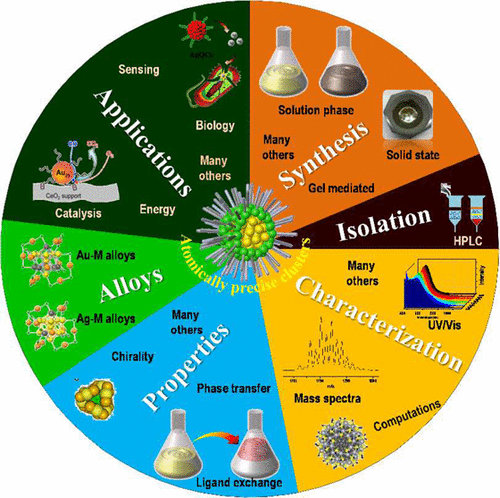当前位置:
X-MOL 学术
›
Chem. Rev.
›
论文详情
Our official English website, www.x-mol.net, welcomes your
feedback! (Note: you will need to create a separate account there.)
Atomically Precise Clusters of Noble Metals: Emerging Link between Atoms and Nanoparticles
Chemical Reviews ( IF 51.4 ) Pub Date : 2017-06-06 00:00:00 , DOI: 10.1021/acs.chemrev.6b00769 Indranath Chakraborty 1 , Thalappil Pradeep 1
Chemical Reviews ( IF 51.4 ) Pub Date : 2017-06-06 00:00:00 , DOI: 10.1021/acs.chemrev.6b00769 Indranath Chakraborty 1 , Thalappil Pradeep 1
Affiliation

|
Atomically precise pieces of matter of nanometer dimensions composed of noble metals are new categories of materials with many unusual properties. Over 100 molecules of this kind with formulas such as Au25(SR)18, Au38(SR)24, and Au102(SR)44 as well as Ag25(SR)18, Ag29(S2R)12, and Ag44(SR)30 (often with a few counterions to compensate charges) are known now. They can be made reproducibly with robust synthetic protocols, resulting in colored solutions, yielding powders or diffractable crystals. They are distinctly different from nanoparticles in their spectroscopic properties such as optical absorption and emission, showing well-defined features, just like molecules. They show isotopically resolved molecular ion peaks in mass spectra and provide diverse information when examined through multiple instrumental methods. Most important of these properties is luminescence, often in the visible–near-infrared window, useful in biological applications. Luminescence in the visible region, especially by clusters protected with proteins, with a large Stokes shift, has been used for various sensing applications, down to a few tens of molecules/ions, in air and water. Catalytic properties of clusters, especially oxidation of organic substrates, have been examined. Materials science of these systems presents numerous possibilities and is fast evolving. Computational insights have given reasons for their stability and unusual properties. The molecular nature of these materials is unequivocally manifested in a few recent studies such as intercluster reactions forming precise clusters. These systems manifest properties of the core, of the ligand shell, as well as that of the integrated system. They are better described as protected molecules or aspicules, where aspis means shield and cules refers to molecules, implying that they are “shielded molecules”. In order to understand their diverse properties, a nomenclature has been introduced with which it is possible to draw their structures with positional labels on paper, with some training. Research in this area is captured here, based on the publications available up to December 2016.
中文翻译:

原子精确的贵金属簇:原子和纳米粒子之间的新兴联系
由贵金属组成的纳米级原子精确物质是具有许多不同寻常性质的新型材料。超过100种这类分子,其分子式如Au 25(SR)18,Au 38(SR)24和Au 102(SR)44以及Ag 25(SR)18,Ag 29(S 2 R)12,和Ag 44(SR)30(通常带有一些抗衡离子来补偿电荷)现在是众所周知的。它们可以通过可靠的合成方案可重复生产,从而形成有色溶液,产生粉末或可衍射晶体。它们与纳米粒子的光谱性质(例如光吸收和发射)明显不同,显示出清晰的特征,就像分子一样。它们在质谱图中显示同位素分辨的分子离子峰,并且通过多种仪器方法检查时可提供多种信息。这些特性中最重要的是发光,通常在可见-近红外窗口中,对生物应用有用。可见光区域的发光,特别是受蛋白质保护的簇的斯托克斯位移大的发光,已用于各种传感应用,在空气和水中可以分解成几十个分子/离子。已经研究了簇的催化性质,尤其是有机底物的氧化。这些系统的材料科学提供了多种可能性,并且正在迅速发展。计算洞察力给出了其稳定性和非凡特性的原因。这些材料的分子性质在最近的一些研究中得到了明确的证明,例如形成精确簇的簇间反应。这些系统表现出核,配体壳以及集成系统的特性。它们被更好地描述为受保护的分子或 计算洞察力给出了其稳定性和非凡特性的原因。这些材料的分子性质在最近的一些研究中得到了明确的证明,例如形成精确簇的簇间反应。这些系统表现出核,配体壳以及集成系统的特性。它们被更好地描述为受保护的分子或 计算洞察力给出了其稳定性和非凡特性的原因。这些材料的分子性质在最近的一些研究中得到了明确的证明,例如形成精确簇的簇间反应。这些系统表现出核,配体壳以及集成系统的特性。它们被更好地描述为受保护的分子或尖刺,其中aspis表示盾牌,而cules则是指分子,这意味着它们是“被屏蔽的分子”。为了了解它们的各种特性,引入了一种命名法,可以通过一些训练在纸上用位置标签绘制其结构。根据截至2016年12月的可用出版物,此处捕获了该领域的研究。
更新日期:2017-06-06
中文翻译:

原子精确的贵金属簇:原子和纳米粒子之间的新兴联系
由贵金属组成的纳米级原子精确物质是具有许多不同寻常性质的新型材料。超过100种这类分子,其分子式如Au 25(SR)18,Au 38(SR)24和Au 102(SR)44以及Ag 25(SR)18,Ag 29(S 2 R)12,和Ag 44(SR)30(通常带有一些抗衡离子来补偿电荷)现在是众所周知的。它们可以通过可靠的合成方案可重复生产,从而形成有色溶液,产生粉末或可衍射晶体。它们与纳米粒子的光谱性质(例如光吸收和发射)明显不同,显示出清晰的特征,就像分子一样。它们在质谱图中显示同位素分辨的分子离子峰,并且通过多种仪器方法检查时可提供多种信息。这些特性中最重要的是发光,通常在可见-近红外窗口中,对生物应用有用。可见光区域的发光,特别是受蛋白质保护的簇的斯托克斯位移大的发光,已用于各种传感应用,在空气和水中可以分解成几十个分子/离子。已经研究了簇的催化性质,尤其是有机底物的氧化。这些系统的材料科学提供了多种可能性,并且正在迅速发展。计算洞察力给出了其稳定性和非凡特性的原因。这些材料的分子性质在最近的一些研究中得到了明确的证明,例如形成精确簇的簇间反应。这些系统表现出核,配体壳以及集成系统的特性。它们被更好地描述为受保护的分子或 计算洞察力给出了其稳定性和非凡特性的原因。这些材料的分子性质在最近的一些研究中得到了明确的证明,例如形成精确簇的簇间反应。这些系统表现出核,配体壳以及集成系统的特性。它们被更好地描述为受保护的分子或 计算洞察力给出了其稳定性和非凡特性的原因。这些材料的分子性质在最近的一些研究中得到了明确的证明,例如形成精确簇的簇间反应。这些系统表现出核,配体壳以及集成系统的特性。它们被更好地描述为受保护的分子或尖刺,其中aspis表示盾牌,而cules则是指分子,这意味着它们是“被屏蔽的分子”。为了了解它们的各种特性,引入了一种命名法,可以通过一些训练在纸上用位置标签绘制其结构。根据截至2016年12月的可用出版物,此处捕获了该领域的研究。











































 京公网安备 11010802027423号
京公网安备 11010802027423号